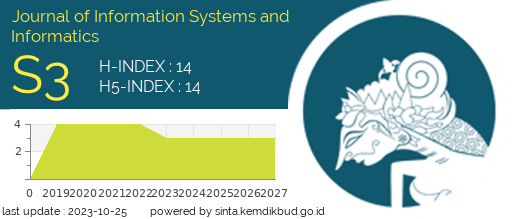Measuring the Benefits of the Skill Academy’s Online Training Platform
Abstract
The research purpose is to prove the truth of an internal survey of 96,406 users of the Academy Skills platform. The results of the survey stated that after participating in the training the user felt an increase in skills. Verification of the correctness of the survey uses a combination of the Delone and McClean (DM) models and the Technology-to-Performance Chain (TPC) model which has 5 constructs: System quality, information quality, service quality, task-Technology Fit, and Net Benefit. The method used in this study is a quantitative method through the development of identified constructs. Quantitative data was obtained from a questionnaire distributed to 96 respondents using the Skill Academy platform. The result of this study is that the constructs of system quality, information quality, and service quality have a positive effect on task-technology fit, and the task-technology fit construct has a positive effect on net benefits. In other words, the skills academy platform has quality systems, information, and services that allow tasks to be accommodated so that the impact is beneficial for users.
Downloads
References
W. H. DeLone and E. R. McLean, “The DeLone and McLean model of information systems success: A ten-year update,” in Journal of Management Information Systems, M.E. Sharpe Inc., 2003, pp. 9–30. doi: 10.1080/07421222.2003.11045748.
D. L. Goodhue and R. L. Thompson, “Task-Technology Fit and Individual Performance,” 1995.
I. Kaniawulan, H. Hendrayani, and C. Furqon, “Successful Digital Payment Information System Services Using Delon and McLean Models,” 2022.
D. Al-Fraihat, M. Joy, R. Masa’deh, and J. Sinclair, “Evaluating E-learning systems success: An empirical study,” Comput Human Behav, vol. 102, pp. 67–86, Jan. 2020, doi: 10.1016/j.chb.2019.08.004.
W. Abdillah and A. Saepullah, “Model Technology to Performance Chain (TPC) in Implementing Accrual-Based Sistem Informasi Manajemen Daerah (SIMDA) Finance: Empirical Evidence from Local Government of Indonesia,” Jurnal Dinamika Manajemen, vol. 9, no. 1, pp. 56–68, Jun. 2018, doi: 10.15294/jdm.v9i1.14652.
A. Ratnasari, A. A. Harahap, A. A. Anshori, and M. Alam, “Adopting task technology fit model on e-voting technology,” International Journal of Informatics and Communication Technology (IJ-ICT), vol. 10, no. 2, p. 148, Aug. 2021, doi: 10.11591/ijict.v10i2.pp148-158.
J. M. Hudin, Y. Farlina, R. A. Saputra, A. Gunawan, D. Pribadi, and D. Riana, "Measuring Quality of Information System Through Delone Mclean Model in Online Information System of New Student Registration (SISFO PPDB)," in 2018 6th International Conference on Cyber and IT Service Management (CITSM), 2018, pp. 1-6.
K. P. Fadahunsi et al., “Protocol for a systematic review and qualitative synthesis of information quality frameworks in eHealth,” BMJ Open, vol. 9, no. 3, Mar. 2019, doi: 10.1136/bmjopen-2018-024722.
R. Widiastuti, B. S. Haryono, and A. Said, "Influence of system quality, information quality, service quality on user acceptance and satisfaction and Its impact on net benefits (study of information system users lecturer performance load (BKD) in Malang State University)," HOLISTICA–Journal of Business and Public Administration, vol. 10, no. 3, pp. 111-132, 2019.
S. Laumer, C. Maier, and T. Weitzel, “Information quality, user satisfaction, and the manifestation of workarounds: a qualitative and quantitative study of enterprise content management system users,” European Journal of Information Systems, no. November 2016, 2017, doi: 10.1057/s41303-016-0029-7.
Wasiran S., Antonius Darma S., and Yanuar Z. A., “Analysis of Cloud Computing Usage in Vocational School Environment Using Delone MClean,” International Journal of Computer and Information System (IJCIS), vol. 3, no. (4), pp.153-157, 2022.
E. Murray, R. Acosta, and R. Avelar, “UB Lecturers Perception of LMS 4th Annual Management Information System Conference,” 2021.
S. K. Lwanga and S. Lemeshow, Sample size determination in health studies : a practical manual.
Joseph F. Hair Jr., William J. Black, Barry J. Babin, and Rolph E. Anderson, Multivariate Data Analysis. pearson Prentice Hall, 2010.
C. Tam and T. Oliveira, “Understanding the impact of m-banking on individual performance: DeLone & McLean and TTF perspective,” Comput Human Behav, vol. 61, pp. 233–244, Aug. 2016, doi: 10.1016/j.chb.2016.03.016.
A. Yuce, A. M. Abubakar, and M. Ilkan, “Intelligent tutoring systems and learning performance: Applying task-technology fit and IS success model,” Online Information Review, vol. 43, no. 4, pp. 600–616, Jul. 2019, doi: 10.1108/OIR-11-2017-0340.
X. Zha, H. Yang, Y. Yan, K. Liu, and C. Huang, “Exploring the effect of social media information quality, source credibility and reputation on informational fit-to-task: Moderating role of focused immersion,” Comput Human Behav, vol. 79, pp. 227–237, Feb. 2018, doi: 10.1016/j.chb.2017.10.038.
J. Heinze and C. Matt, “Reducing the Service Deficit in M-Commerce: How Service-Technology Fit Can Support Digital Sales of Complex Products,” International Journal of Electronic Commerce, vol. 22, no. 3, pp. 386–418, Jul. 2018, doi: 10.1080/10864415.2018.1462940.
I. Y. Alyoussef, “Acceptance of e-learning in higher education: The role of task-technology fit with the information systems success model,” Heliyon, vol. 9, no. 3, Mar. 2023, doi: 10.1016/j.heliyon.2023.e13751.
 Abstract views: 1621 times
Abstract views: 1621 times Download PDF: 1000 times
Download PDF: 1000 times
Copyright (c) 2023 Journal of Information Systems and Informatics

This work is licensed under a Creative Commons Attribution 4.0 International License.
- I certify that I have read, understand and agreed to the Journal of Information Systems and Informatics (Journal-ISI) submission guidelines, policies and submission declaration. Submission already using the provided template.
- I certify that all authors have approved the publication of this and there is no conflict of interest.
- I confirm that the manuscript is the authors' original work and the manuscript has not received prior publication and is not under consideration for publication elsewhere and has not been previously published.
- I confirm that all authors listed on the title page have contributed significantly to the work, have read the manuscript, attest to the validity and legitimacy of the data and its interpretation, and agree to its submission.
- I confirm that the paper now submitted is not copied or plagiarized version of some other published work.
- I declare that I shall not submit the paper for publication in any other Journal or Magazine till the decision is made by journal editors.
- If the paper is finally accepted by the journal for publication, I confirm that I will either publish the paper immediately or withdraw it according to withdrawal policies
- I Agree that the paper published by this journal, I transfer copyright or assign exclusive rights to the publisher (including commercial rights)






















_1.png)












